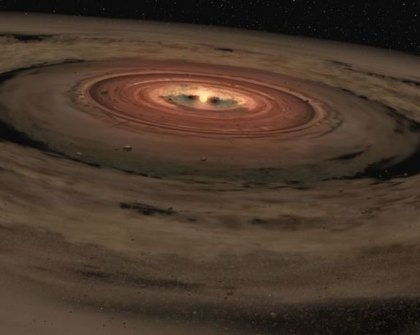Jupiter had star turn in solar system's formation

Gas swirling around a young star. Artist's concept: NASA.
A newly released research paper hypothesizes that Jupiter drove earlier planets into the sun. The debris that remained helped form the solar system in existence today, according to the article, "Jupiter's Decisive Role in the Solar System's Early Evolution," published in the Proceedings of the National Academy of Sciences.
The paper, by Konstantin Batygin, assistant professor of planetary science at the California Institute of Technology, and Greg Laughlin, an astrophysicist from the University of California Observatories, describes our solar system as “an unusual member of the galactic planetary census in that it lacks planets that reside in close proximity to the sun.”
In other words, it is nothing like the numerous, more-compact systems where planets whip swiftly around a star in days or months. Researchers offer the Kepler-11 system as an example. That solar system, named for NASA’s Kepler space telescope, was described by scientists as having a large number of planets in orbit close to the star.
So how did our solar system become so different? In a previous study involving NASA researchers, scientists theorized that as the system formed, Jupiter – and Saturn -- shifted in currents of flowing gas that swirled around the sun.
In this new article, researchers speculate that “at the time of Jupiter’s inward journey, a similar population of first-generation planets existed in the solar system. If such planets formed, however, they were destroyed.”
So any pre-existing planets would have been driven into the sun. Once the gas was expelled, Jupiter and Saturn reversed direction and shifted back out again.
Terrestrial planets formed from the remaining debris. Scientists noted that their conclusions could be validated by NASA missions -- specifically TESS (Transiting Exoplanet Survey Satellite), approved for implementation in 2014, and the K2 mission, another project using the Kepler space telescope.
Recommended:
Read the study here: Jupiter's decisive role in the solar system's early evolution.
Read about the earlier study on Jupiter's travels NASA’s website.
Read about the Kepler 11 system on NASA's website.
Related:
Jumbo Earth-sized planet orbits star
NASA marks verification of 1,000th planet

